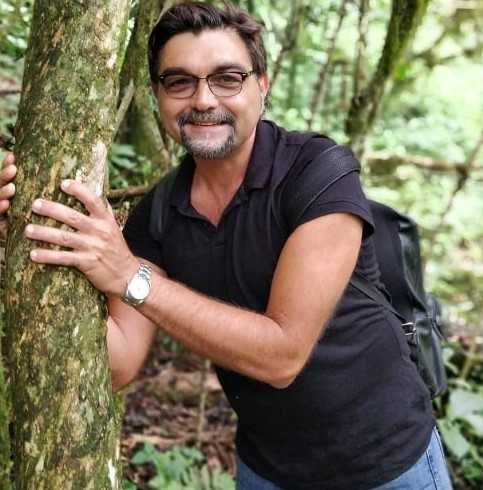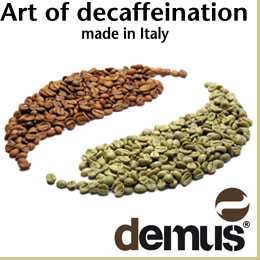MILAN – Marc Tormo Altimira is a coffee entrepreneur, roaster, brewer and creative consultant, with more than 20 years of international experience in the specialty coffee movement. After visiting India in 1990, from Barcelona to Bombay to Delhi and Kolkata, he now lives in Auroville.
In the 2008 he founded Coffee Ideas!, one of the very first companies in India to roast high quality certified coffees ( bio-dynamic, organic, fair trade and UTZ certified ) in small batches for the Indian gourmet market, under the brand name of “Marc’s coffee” Indian Fine Coffees.
And he is also co-founder of Marc’s Cafe, Roast & Taste, (2011) a boutique cafe and of Catami, Dreamer’s cafe, (2013) at Auroville Visitor’s center, and upcycled container turned into a solar cafe brewing Marc’s coffees.
We spoke to him.
Tormo, at 23, you opened your first coffee boutique in Barcelona, then travel to India led you to found Coffee Ideas: what did you see in Indian coffee that won you over at the time?
“The huge potential of India as a new specialty coffee origin which not only will stand out for its unique flavour profile but also the sustainability of its agroforestry practices, growing coffee under a canopy of indigenous trees, thus preserving the biodiversity of the areas of coffee cultivation.”
From when you started until today, also through activities like yours, Coffee Ideas!, has Indian coffee changed in terms of quality?
“The coffee quality has improved tremendously, due better post harvesting, better roasting and brewing lead by a increased of demand of specialty coffee”.
Are Indian farmers studying and researching new agricultural practices to evolve crops and also shield them from climate and disease?
“Yes, the fact the coffee is grown under the canopy is a big advantage as the temperatures are always cooler under the shade of trees. The moisture also is kept in the soil, and more carbon sequestration is possible under these conditions. Controlled drying is also adopted to ensure safe and more controlled drying process.”
Is specialty coffee representative of the Indian market or is it still emerging?
“Varieties of coffee are been used based on quality cup rather than only quantity. Example is the resurgence of Kent variety. Kent variety was developed in the 1930′s to address the coffee leaf rust, yet with an excellent cup profile.
The yield though is not as much as other hybrids introduced in recent years, which are designed to yield more, but compromising on the quality cup.
Also Kent resistance to leaf rust has minimized due the adaptation of different strains of “hemileia vastratix”, nevertheless, this typica variety continues to grow in India, Kenya and Uganda, at higher elevations producing a great quality cup, with good prospects to be distinct from other cultivars.
Varieties like Geisha have been planted in recent years, by few progressive planters, results of adaptability and quality cup still in to be proven, but they look promising, particularly in high elevations.
The specialty coffee culture is in full emergence, the younger generations are quickly swigging to specialty coffee over instant or traditional comercial brands.
The emergence of cafes and coffee as a lifestyle product is gaining popularity amongst the younger generations. Youngsters in metros prefer coffee over tea, and particularly specialty coffee.
Once they try the complexity of a well produced and artisanal roasted coffee, they simply can’t go back to instant coffee or other cometial brands. Home brewing has become too and fashion, due the Covid 19 pandemic.
Many people started attending live sessions on how to brew a perfect cup at home.
The logistics and easy home delivery services offered by artisan roasters, helpt the penetration of this niche product to a wider audience.
Now the Covid 19 is gone, the trend continues, as well as going to specialty cafes. Another aspect that makes India a perfect specialty market is that it is a producing country, coffee aficionados can visit the coffee plantations and learn from crop to cup workshops organized by specialty brands and leading coffee estates. “
How is Indian coffee positioned in the market? What are the main varieties that come from these origins and to where they are mainly exported
“The Indian coffees are exported mainly to Italy for espresso blends. Germany, Russia and Spain are also countries that imports coffees from India.
Specialty lots are exported to US and Europe to artisans roaster that value the distinct flavours of Indian coffee.
What percentage of the total coffee production in India does the specialty represent today? I do not have exact figures, but my understanding based on the estimated crop 23-24 will be around between 20 and 40 tones of 85+ scoring coffees.
Does this new push towards specialties lead to a better price for farmers, who consequently see this profession as a long-term career (counteracting the phenomenon of abandonment of the fields that is very much felt at the origin)?
“The little specialty coffee availability and the increasing demand make the price be much above the commodity market, hence fetching lucrative margins too.”
Speaking instead of domestic consumption: how is coffee drunk (by which method of extraction and roasted in what way), is it growing in comparison to tea?

“Espresso machines are now easily available with good customer service, aeropress competitions also help to bring the manual brewing into the lifestyle over tea. Cold brew ready to drink and easy pour sachets are helping new coffee aficionados to consume specialty coffee in a convenient way. “
At some point, you found two different cafés, Marc’s Cafe, Roast & Taste and Dreamer’s cafe: what coffee do you drink in them and how do you drink it?
“In our cafes , espresso based drinks are well accepted with growing demand over traditional South Indian coffee method. Pour overs and manual brews are gaining popularity by the day. We operate 2 cafes.
Dreamers cafe is located at a tourist complex with stores and restaurants, with a big footfall. The customer profile is looking for a more economic offer, of first seller is South Indian Coffee Filter, a traditional gravity method that produces a strong black brew, combined with hot milk. Usually it is served ina brass tumbler and a saucer called dabarah.
The frothy and strong brew is consumed with sugar and accompanied with salty snacks like the famous samosa. It is brew in south india households for breakfast and to make it more affordable to the wider market it is mixed with chicory.
At Marc’s we have crafted a South Indian coffee blend called Buma Devi ( goddess of the Earth, in Tamil language), this blend is sourced in Wayanad, Kerala by a cluster of tribals, fully grown without any pesticides it is organic certified.
The other cafe is located in Auroville main road, called Marc’s cafe – store, and cater to the specialty coffee aficionados.
At Marc’s we have more than 10 different specialty coffees from different Indian growing regions, we sell the freshly roasted beans and the coffee menu offers a wide range; from espresso based, to cold drips, V60 and AeroPress.
At Marc’s we use state of the art machines, like Astoria Storm, and Mazzer grinder to mention a few. Not to say that such a variety of coffee is accompanied by delicious homemade French croissants and other delicacies like Turkish Baklavas. “
The website: marcscoffees.com. Instagram @marcscoffees / @marcs_cafe/ @dreamerscafe
















